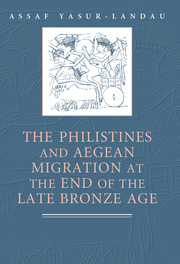Book contents
- Frontmatter
- Contents
- Acknowledgments
- INTRODUCTION
- 1 THE ARCHAEOLOGICAL IDENTIFICATION OF MIGRATION AND OTHER RANGES OF INTERREGIONAL INTERACTIONS
- 2 SETTING THE SCENE: THE MYCENAEAN PALATIAL CULTURE AND THE OUTSIDE WORLD
- 3 THE TWELFTH-CENTURY-BCE AEGEAN: POLITICAL AND SOCIAL BACKGROUND
- 4 PRECONDITIONS FOR MIGRATION
- 5 ALONG THE ROUTES
- 6 STRICTLY BUSINESS? THE SOUTHERN LEVANT AND THE AEGEAN IN THE THIRTEENTH TO THE EARLY TWELFTH CENTURY BCE
- 7 THE MATERIAL CULTURE CHANGE IN TWELFTH-CENTURY PHILISTIA
- 8 THE PHILISTINE SOCIETY AND THE SETTLEMENT PROCESS
- 9 A SHORT HISTORY OF THE AEGEAN IMMIGRATION TO THE LEVANT
- Bibliography
- Index
7 - THE MATERIAL CULTURE CHANGE IN TWELFTH-CENTURY PHILISTIA
Published online by Cambridge University Press: 04 August 2010
- Frontmatter
- Contents
- Acknowledgments
- INTRODUCTION
- 1 THE ARCHAEOLOGICAL IDENTIFICATION OF MIGRATION AND OTHER RANGES OF INTERREGIONAL INTERACTIONS
- 2 SETTING THE SCENE: THE MYCENAEAN PALATIAL CULTURE AND THE OUTSIDE WORLD
- 3 THE TWELFTH-CENTURY-BCE AEGEAN: POLITICAL AND SOCIAL BACKGROUND
- 4 PRECONDITIONS FOR MIGRATION
- 5 ALONG THE ROUTES
- 6 STRICTLY BUSINESS? THE SOUTHERN LEVANT AND THE AEGEAN IN THE THIRTEENTH TO THE EARLY TWELFTH CENTURY BCE
- 7 THE MATERIAL CULTURE CHANGE IN TWELFTH-CENTURY PHILISTIA
- 8 THE PHILISTINE SOCIETY AND THE SETTLEMENT PROCESS
- 9 A SHORT HISTORY OF THE AEGEAN IMMIGRATION TO THE LEVANT
- Bibliography
- Index
Summary
FROM CANAAN TO PHILISTIA
The southern coastal plain of Israel and the adjacent Shephela (lower foothills, two hundred meters above sea level) experienced turmoil in the transition from the thirteenth century to the twelfth century bce, similar to many other regions of the eastern Mediterranean (Fig. 7.1). Through most of the thirteenth century, a system of Canaanite city-states controlled the area, with centers at Lachish, Tell es-Ṣafi/Gath, Ashkelon, Gezer, and Gaza or Yurza, continuing a system that had existed throughout most of the Late Bronze Age and was recorded in fourteenth-century el-Amarna Letters (Finkelstein 1996a: fig. 1). Egyptian garrisons and forts, as in Deir el-Balah south of Gaza; Tel Mor, the harbor site of Ashdod; and Tel Seraʿ in the Besor area, ensured the Nineteenth Dynasty's grip on the area, the latter continuing to the twelfth century bce (Killebrew 2006: 60–4).
Although it endured the last decade of the thirteenth century, the system of Canaanite city-states received a considerable blow from the campaigns of Pharaoh Merneptah, who recorded in the famous Israel Stele the obliteration of two of the centers of the Canaanite polities, at Gezer and at Ashkelon: “Canaan is plundered with every evil; Ashkelon is conquered; Gezer is seized” (Stager 1985: *56; Rainey 2003: 181). The violent siege and conquest of Ashkelon, depicted also in a relief in Karnak, was possibly accompanied by the placing of an Egyptian garrison in a newly built fort (Fig. 7.2; Master 2005: 340).
- Type
- Chapter
- Information
- Publisher: Cambridge University PressPrint publication year: 2010



